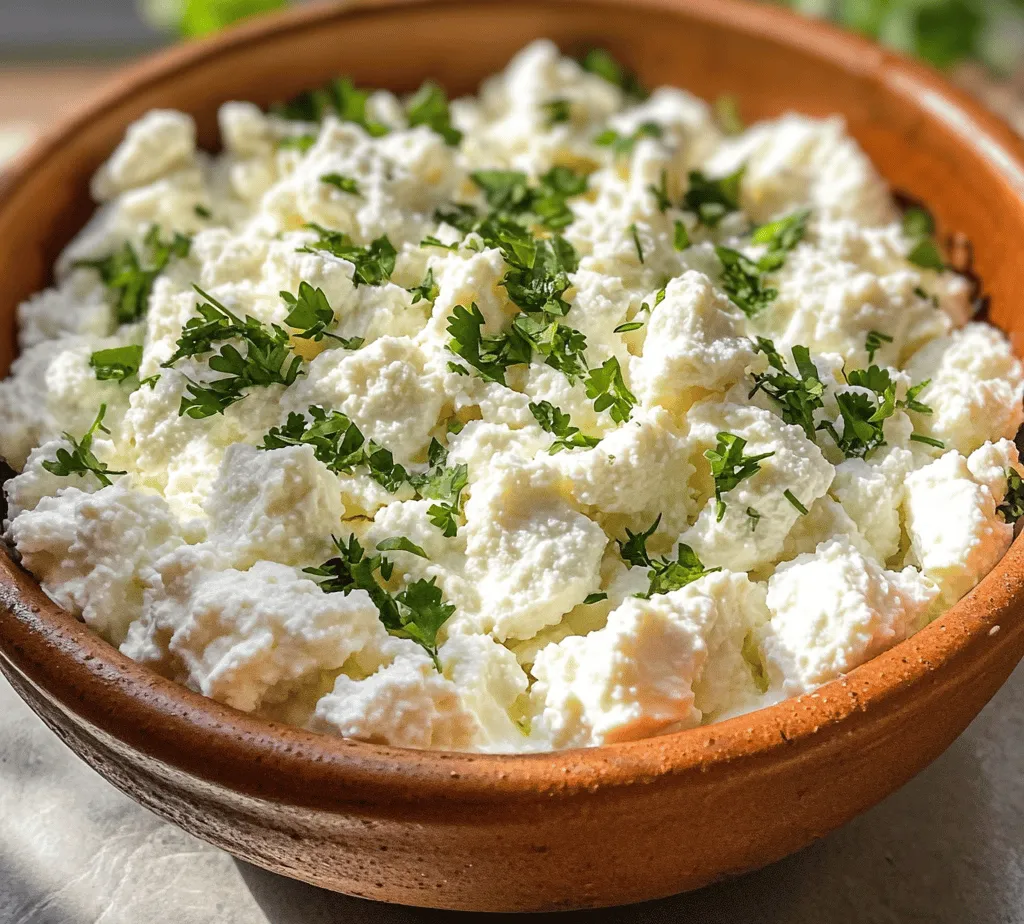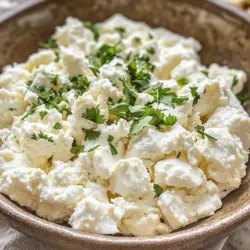Introduction
Exploring the world of homemade cheeses opens up a realm of culinary possibilities, and making your own Queso Fresco is a delightful experience that anyone can enjoy. This fresh, crumbly cheese is not only versatile but also incredibly easy to make with just a few simple ingredients. Whether you’re a seasoned home cook or a beginner, crafting Queso Fresco at home is an enjoyable project that offers both delicious results and a sense of accomplishment.
In this article, we will guide you through the process of creating your own Queso Fresco Fiesta, highlighting its origins, the health benefits of homemade cheese, and how to incorporate this delicious ingredient into your meals. From its roots in Latin America to the nutritional advantages of making cheese from scratch, we’ll explore everything you need to know to get started on this flavorful journey.
The Origins of Queso Fresco
Understanding the roots of Queso Fresco adds depth to your culinary experience and appreciation for this delightful cheese. Queso Fresco, which translates to “fresh cheese” in Spanish, is a staple in many Latin American countries, particularly in Mexico and Central America.
Culinary Heritage of Queso Fresco
The culinary heritage of Queso Fresco is rich and diverse. It has been a fundamental part of Latin American cuisine for centuries, often used in traditional dishes such as enchiladas, tacos, and salads. Its mild flavor and crumbly texture make it the perfect complement to a variety of dishes, enhancing flavors without overwhelming them.
Traditional Uses in Latin American Cuisine
In Mexican cuisine, Queso Fresco is often crumbled over dishes like chilaquiles, used as a topping for tamales, or served alongside fresh salsas. Its ability to balance spicy flavors makes it a beloved ingredient in many households. Beyond Mexico, different Latin American cultures have incorporated Queso Fresco into their culinary practices, showcasing its versatility and widespread appeal.
Regional Variations and Flavor Profiles
While Queso Fresco is enjoyed in various forms throughout Latin America, regional variations exist that offer unique flavor profiles. For example, some regions may add herbs or spices to their cheese, resulting in a slightly different taste that reflects local ingredients and traditions. Exploring these variations can inspire you to experiment when making your own Queso Fresco at home.
Health Benefits of Homemade Queso Fresco
Making cheese at home not only allows you to enjoy fresh flavors but also comes with several health benefits.
Nutritional Advantages of Making Cheese at Home
One of the primary advantages of homemade Queso Fresco is the control you have over the ingredients. By opting for high-quality, whole milk, you ensure that your cheese is rich in essential nutrients such as calcium and protein. Furthermore, homemade cheese typically contains fewer preservatives and additives compared to store-bought varieties, making it a healthier choice for you and your family.
Comparison of Homemade vs. Store-Bought Queso Fresco
When comparing homemade Queso Fresco to store-bought options, it’s important to note the difference in flavor and texture. Homemade cheese is fresher, with a creamy richness that store-bought versions may lack. Additionally, you can customize the flavor of your Queso Fresco by experimenting with different herbs and spices, tailoring it to your taste preferences.
The Role of Fresh Ingredients in Promoting a Healthy Diet
The use of fresh ingredients in your homemade Queso Fresco contributes to a healthy diet. Whole milk not only provides essential vitamins and minerals but also supports overall well-being. By making cheese at home, you can incorporate local and organic ingredients, ensuring that your cooking aligns with your health goals.
Ingredients Breakdown
Creating Queso Fresco requires only a few simple ingredients, each playing a crucial role in the cheese-making process.
A Closer Look at the Components of Queso Fresco
The primary ingredients for making Queso Fresco are whole milk, vinegar, and salt. Each of these components contributes to the cheese’s texture and flavor, making them essential for a successful outcome.
Importance of High-Quality Whole Milk
The foundation of delicious Queso Fresco lies in the quality of the milk you use. Opt for fresh, high-quality whole milk to achieve the best results. The fat content in whole milk helps create a creamy texture in the cheese, while also enhancing its flavor.
The Role of Vinegar in Curdling and Flavor
Vinegar is crucial in the cheese-making process, acting as the curdling agent that separates the curds from the whey. The type of vinegar you choose can also influence the cheese’s flavor. White vinegar is commonly used, but apple cider vinegar can add a subtle sweetness that enhances the overall taste.
Exploring Optional Herbs for Added Taste
For those looking to elevate their Queso Fresco, consider incorporating fresh herbs or spices. Ingredients like cilantro, oregano, or even red pepper flakes can be mixed into the curds before pressing, adding a new dimension of flavor to your cheese. Experimenting with different herbs allows you to create a unique version of Queso Fresco tailored specifically to your palate.
Step-by-Step Guide to Making Queso Fresco
Now that you’re familiar with the origins, health benefits, and ingredients of Queso Fresco, it’s time to roll up your sleeves and start making this delightful cheese. Here’s a detailed step-by-step guide to help you through the process.
Step 1: Gather Your Ingredients and Equipment
Before you begin, make sure you have all the necessary ingredients and equipment on hand. You will need:
- 1 gallon of high-quality whole milk
- 1/2 cup of vinegar (white or apple cider)
- 1 teaspoon of salt
- A large pot
- A slotted spoon
- A fine mesh strainer or cheesecloth
Step 2: Heat the Milk
In a large pot, pour the whole milk and place it over medium heat. Heat the milk slowly, stirring occasionally to prevent it from scorching on the bottom. You want to bring the milk to a gentle simmer, around 190°F (88°C), but do not let it boil.
Step 3: Add the Vinegar
Once the milk reaches the desired temperature, remove the pot from the heat. Slowly add the vinegar while gently stirring the milk. You should begin to see the curds forming as the milk separates into curds and whey. Allow the mixture to sit for about 5-10 minutes to let the curds fully develop.
Step 4: Strain the Curds
Using a slotted spoon, carefully transfer the curds into a fine mesh strainer or cheesecloth. Make sure to catch the whey, as it can be saved for other uses, such as smoothies or baking. Let the curds drain for about 10-15 minutes, depending on how moist you want your cheese to be.
Step 5: Season the Curds
After draining, transfer the curds to a mixing bowl. Add the salt and any optional herbs or spices you desire. Gently mix until the salt is evenly distributed throughout the cheese, adjusting the seasoning to taste.
With these steps, you are well on your way to creating your own Queso Fresco Fiesta. In the following sections, we will delve deeper into tips for best results, common questions about the cheese-making process, and creative ways to incorporate your homemade Queso Fresco into various dishes. Stay tuned for the next part of this delicious journey!

Detailed Instructions to Ensure Success in Your Cheese-Making Journey
Making Queso Fresco at home is a fulfilling process that can transform your culinary repertoire. To achieve the best results, it’s essential to understand each step of the cheese-making process, from heating the milk to storing your finished product. Follow these detailed instructions to ensure that your Queso Fresco turns out perfectly every time.
Heating the Milk: Achieving the Perfect Temperature
The first step in making Queso Fresco is to heat the milk to the right temperature. Pour your milk into a large, heavy-bottomed pot and place it over medium heat. Stir the milk gently with a wooden spoon to prevent it from scorching on the bottom. The goal is to heat the milk to around 190°F (88°C). This temperature is crucial as it helps to prepare the milk proteins for curdling.
Use a reliable kitchen thermometer to monitor the milk’s temperature closely. As the milk heats up, you may notice small bubbles forming around the edges. Once the temperature reaches 190°F, remove the pot from the heat immediately. This step is vital as overheating can lead to a rubbery texture in your cheese.
Curdling the Milk: The Science Behind the Process
Now that your milk is heated, it’s time to curdle it. The curdling process is where the magic happens. Slowly add the white vinegar or lemon juice to the hot milk while gently stirring. You should see curds begin to form almost instantly. This reaction occurs because the acid causes the proteins in the milk to coagulate, separating into solid curds and liquid whey.
Once you have added the acid, stop stirring and let the mixture sit undisturbed for about 10 minutes. During this resting period, the curds will firm up, and you should notice a clear separation between the curds and whey. If the curds are not forming adequately, you may need to add a bit more acid until you achieve the desired consistency.
Straining the Curds: Techniques for Optimal Texture
After the curds have formed, it’s time to strain them. Place a fine-mesh strainer or cheesecloth over a large bowl to catch the whey. Carefully ladle the curds into the strainer, allowing the whey to drain away. If you prefer a drier cheese, let the curds strain for a longer period. For a creamier texture, you can strain for a shorter time.
Once most of the whey has drained, fold the cheesecloth over the curds and press gently to remove any excess moisture. Be cautious not to press too hard, as this can lead to compacted cheese. The goal is to achieve a crumbly yet moist texture that is characteristic of Queso Fresco.
Flavoring Your Cheese: Balancing Salt and Herbs
Now that you have your curds, it’s time to season them. Transfer the curds to a mixing bowl and sprinkle in salt to taste. A good starting point is about 1 teaspoon of salt per cup of curds. Mix the salt in gently, taking care not to break the curds too much.
To elevate the flavor, consider adding fresh herbs like cilantro, chives, or parsley, or even spices such as cumin or smoked paprika. Incorporating these ingredients will give your cheese a unique twist that can enhance various dishes. Remember to taste as you go to find the perfect balance.
Molding and Storing Your Cheese: Tips for Presentation and Longevity
Once your cheese is seasoned, it’s time to mold it. Line a small bowl or cheese mold with cheesecloth, allowing enough overhang to fold over the top. Spoon the curds into the mold, pressing down gently to create a compact shape. Fold the cheesecloth over the top and place a weight on it to help the cheese hold its shape as it continues to drain.
Let the cheese sit at room temperature for about an hour. After this, transfer it to the refrigerator. Homemade Queso Fresco can be kept in the fridge for about 1-2 weeks when stored in an airtight container. For best results, try to consume it within the first week for optimal freshness and flavor.
Serving Suggestions for Queso Fresco
Queso Fresco is incredibly versatile and can be used in a variety of dishes. Here are some creative ways to incorporate this delightful cheese into your meals:
Creative Ways to Incorporate Queso Fresco into Your Meals
1. Tacos: Crumble Queso Fresco over your favorite tacos. It adds a creamy texture and a salty punch that complements the spiciness of the meat or veggies perfectly.
2. Salads: Sprinkle Queso Fresco on top of salads for a refreshing twist. It pairs beautifully with ingredients like avocado, black beans, and corn.
3. Stuffed Peppers: Mix Queso Fresco into the filling for stuffed peppers or enchiladas for added creaminess and flavor.
Toppings and Pairings for Tacos and Salads
For taco night, consider using Queso Fresco alongside traditional toppings such as diced onions, cilantro, and lime juice. For salads, combine it with fresh ingredients like tomatoes, cucumbers, and a zesty vinaigrette. The cheese not only enhances flavor but also adds a beautiful aesthetic to your dishes.
Using Queso Fresco in Appetizers and Main Dishes
Queso Fresco can also shine in appetizers and main dishes. Use it in quesadillas, where it melts beautifully, or mix it into your favorite pasta dishes for added creaminess. For a simple appetizer, serve it with a drizzle of olive oil and a sprinkle of herbs, alongside crusty bread or crackers.
Ideas for Serving with Fresh Bread or as a Standalone Snack
For a delightful snack, pair Queso Fresco with fresh bread. Spread some onto toasted baguette slices, and top with fresh tomatoes and basil for a Mediterranean twist. Alternatively, serve it as a standalone snack with olives and nuts for a simple yet elegant cheese board.
Storage and Shelf Life of Queso Fresco
Proper storage is crucial to maintaining the quality of your homemade Queso Fresco. Here are some best practices:
Best Practices for Storing Homemade Cheese
- Place the cheese in an airtight container to prevent moisture loss and protect it from absorbing odors from the fridge.
- If the cheese is cut into pieces, wrap each piece in wax paper or parchment paper before placing it in the container. This helps preserve the texture.
Understanding the Shelf Life of Queso Fresco
Homemade Queso Fresco typically lasts about 1-2 weeks in the refrigerator. To enjoy it at its peak freshness, keep track of the date you made it. If you find yourself with extra cheese, consider freezing it in small portions to extend its shelf life. Just be mindful that freezing may slightly alter the texture.
Signs of Spoilage and How to Avoid Waste
Be vigilant about signs of spoilage. If you notice any mold, off smells, or a slimy texture, it’s best to discard the cheese. To avoid waste, try to only make the amount you can consume within a week, or share your homemade Queso Fresco with friends and family.
Conclusion
Making Queso Fresco at home can be a rewarding culinary endeavor that enhances your meals and provides a sense of accomplishment. With minimal ingredients and straightforward instructions, you can enjoy the fresh taste and unique texture of this cheese in your favorite dishes. Whether you’re crumbling it over tacos or savoring it with crusty bread, homemade Queso Fresco is sure to elevate your dining experience. Embrace the joy of cheese-making and delight in the flavors of this traditional staple. The journey of creating your cheese not only enriches your cooking skills but also allows you to share delicious experiences with loved ones. Enjoy the process, and let your culinary creativity shine with every bite of your homemade Queso Fresco.


